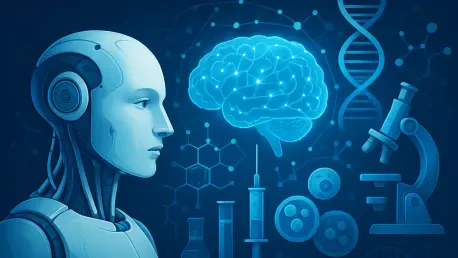In an era where global health challenges demand unprecedented innovation, artificial intelligence (AI) stands as a beacon of hope for the life sciences industry, with 75% of CEOs prioritizing it as a top investment area according to recent industry surveys. This staggering statistic underscores a pivotal shift, as AI emerges as a tool not just for enhancement but for revolutionizing how drugs are discovered, patients are treated, and operations are streamlined. The convergence of vast data sets and advanced algorithms offers a glimpse into a future where healthcare solutions are faster, more precise, and deeply personalized.
This review delves into the transformative role of AI within life sciences, exploring its core applications, current trends, and the tangible impacts it has already achieved. By examining both the opportunities and the hurdles, this analysis aims to provide a comprehensive understanding of how AI is reshaping an industry at the forefront of human well-being. The focus is on real-world outcomes and the strategic priorities driving adoption among industry leaders.
Core Features and Applications of AI
Revolutionizing Drug Discovery and Development
AI’s ability to process enormous datasets at lightning speed has redefined drug discovery, a process historically plagued by high costs and lengthy timelines. By leveraging machine learning algorithms, AI can predict molecular interactions and identify promising therapeutic compounds with remarkable accuracy. This capability significantly reduces the time-to-market for new drugs, often shaving years off development cycles and cutting costs by millions, making it a game-changer for tackling complex diseases.
Beyond speed, AI enhances precision in identifying drug candidates that traditional methods might overlook. It analyzes biological and chemical data to forecast potential outcomes, allowing researchers to focus on the most viable options. This targeted approach not only boosts efficiency but also increases the likelihood of successful outcomes in addressing unmet medical needs.
Advancing Personalized Medicine and Patient Care
In the realm of patient care, AI is paving the way for personalized medicine by integrating genomics, predictive analytics, and real-time patient data. This technology enables healthcare providers to tailor treatments to individual profiles, improving diagnostic accuracy and optimizing therapeutic strategies. For instance, AI-driven tools can detect patterns in genetic data that inform customized cancer therapies, ensuring better outcomes for patients.
The impact on patient-centric care is profound, as AI systems assist in early disease detection and continuous monitoring. By synthesizing data from wearables and medical records, these systems offer insights that empower clinicians to make informed decisions swiftly. Such advancements highlight AI’s potential to transform healthcare delivery into a more proactive and individualized experience.
Performance and Industry Adoption Trends
Investment Surge and Strategic Focus
The life sciences sector is witnessing a sharp rise in AI adoption, with 73% of industry leaders planning to allocate 10–20% of their budgets to AI initiatives over the next 12 months. This investment surge reflects a strong belief in AI’s capacity to drive operational enhancements, with a particular emphasis on agentic AI and intelligent manufacturing. A notable 65% of executives expect a rapid return on investment within one to three years, signaling confidence in quick, measurable results.
Current trends also reveal a focus on integrating AI into product development and service delivery. Approximately 79% of leaders are targeting AI for innovation in these areas, aiming to maintain a competitive edge in a rapidly evolving market. Despite economic uncertainties, there is a growing consensus that AI is indispensable for long-term success, shaping strategic priorities across the board.
Workforce Readiness and Operational Shifts
Alongside technological investment, workforce development is a critical component of AI integration, with 85% of CEOs identifying upskilling as essential for organizational growth over the next few years. Long-term strategies spanning two to five years are being adapted to prioritize talent retention and retraining, ensuring that employees are equipped to handle AI-driven tools. This focus on human capital underscores the need for a balanced approach to technological advancement.
Operational shifts are also evident as companies rethink supply chain resilience through AI applications. By enhancing forecasting and logistics with intelligent systems, the industry aims to ensure the confident global delivery of breakthrough therapies. These efforts demonstrate a holistic view of AI as both a technological and organizational catalyst.
Real-World Impact and Breakthroughs
Operational Enhancements and Innovation
AI’s practical applications in life sciences extend beyond research to significant operational improvements. From optimizing laboratory workflows to automating regulatory compliance processes, AI-driven solutions are enhancing efficiency across the board. These tools enable companies to allocate resources more effectively, reducing waste and accelerating project timelines.
In product innovation, AI is facilitating the creation of novel therapies and delivery mechanisms. For example, intelligent manufacturing systems powered by AI are streamlining production processes, ensuring higher quality and consistency in drug output. Such advancements are critical for meeting the growing demand for innovative healthcare solutions in a competitive landscape.
Unique Implementations in Healthcare Delivery
Specific use cases further illustrate AI’s transformative potential, such as its role in therapy delivery for chronic conditions. AI platforms are being used to monitor patient adherence and adjust treatment plans in real time, improving outcomes for diseases like diabetes. Additionally, unique implementations in predictive maintenance for medical equipment showcase how AI can prevent downtime and ensure seamless healthcare operations, ultimately benefiting patient care.
Challenges Hindering Widespread Adoption
Ethical and Regulatory Concerns
Despite its promise, AI integration faces significant barriers, with 66% of industry leaders citing ethical concerns as a major obstacle. Issues surrounding bias in algorithms and the moral implications of automated decision-making are at the forefront of this debate. Addressing these concerns requires robust ethical frameworks to ensure that AI applications align with societal values and patient trust.
Regulatory pressures pose another substantial challenge, with 74% of executives noting their impact on future prosperity. Compliance with stringent guidelines across different regions complicates AI deployment, often delaying implementation. Collaborative efforts between industry stakeholders and policymakers are underway to streamline regulations while maintaining safety and efficacy standards.
Security Risks and Technical Hurdles
Security risks are a pressing issue, as 60% of leaders express deep concern over fraud detection and prevention, alongside worries about data privacy and identity theft. The sensitive nature of healthcare data necessitates airtight cybersecurity measures to protect against breaches and maintain public confidence. Investments in secure infrastructure are critical to mitigating these risks.
Technical challenges, such as integrating AI with legacy systems and ensuring scalability, also hinder adoption. Many organizations struggle with the complexity of overhauling existing processes to accommodate new technologies. Overcoming these hurdles demands a strategic approach, combining innovation with practical solutions to ensure seamless implementation.
Future Trajectory and Opportunities
Anticipated Advancements and Innovations
Looking ahead, AI is poised to drive further advancements in drug development, with the potential to uncover novel compounds for rare diseases through enhanced predictive modeling. In personalized care, emerging AI tools could enable even more granular treatment customization, leveraging real-time data from diverse sources. These developments promise to address pressing global health challenges with unprecedented precision.
Operational efficiency is another area ripe for growth, as AI systems evolve to optimize every facet of the life sciences value chain. From supply chain logistics to clinical trial management, the technology offers opportunities to reduce costs and improve outcomes. The industry stands to benefit immensely from these innovations over the coming years.
Balancing Innovation with Responsibility
The long-term impact of AI will depend on balancing innovation with ethical and regulatory alignment. As the technology matures, opportunities to deliver breakthrough therapies must be weighed against the need for transparency and accountability. Industry collaboration will be key to establishing guidelines that foster trust while encouraging progress, ensuring that AI’s benefits are realized responsibly.
Reflecting on AI’s Journey in Life Sciences
Looking back, the journey of AI in life sciences reveals a landscape of immense potential tempered by significant challenges. The technology has proven its worth in accelerating drug discovery, enhancing personalized care, and driving operational efficiencies, with substantial investments reflecting industry confidence. However, ethical dilemmas, regulatory complexities, and security concerns underscore the need for careful navigation.
As a next step, stakeholders must prioritize the development of comprehensive ethical frameworks and robust cybersecurity protocols to safeguard progress. Collaborative efforts between industry leaders, regulators, and technology experts will be essential to address these barriers effectively. Additionally, continued investment in workforce upskilling should remain a focus to ensure that human capital keeps pace with technological advancements.
Ultimately, the path forward lies in fostering an ecosystem where innovation thrives alongside responsibility. By committing to strategic partnerships and proactive solutions over the coming years, the life sciences sector can harness AI’s full potential to deliver life-changing therapies. This balanced approach will solidify AI as a cornerstone of resilience and progress in healthcare.









